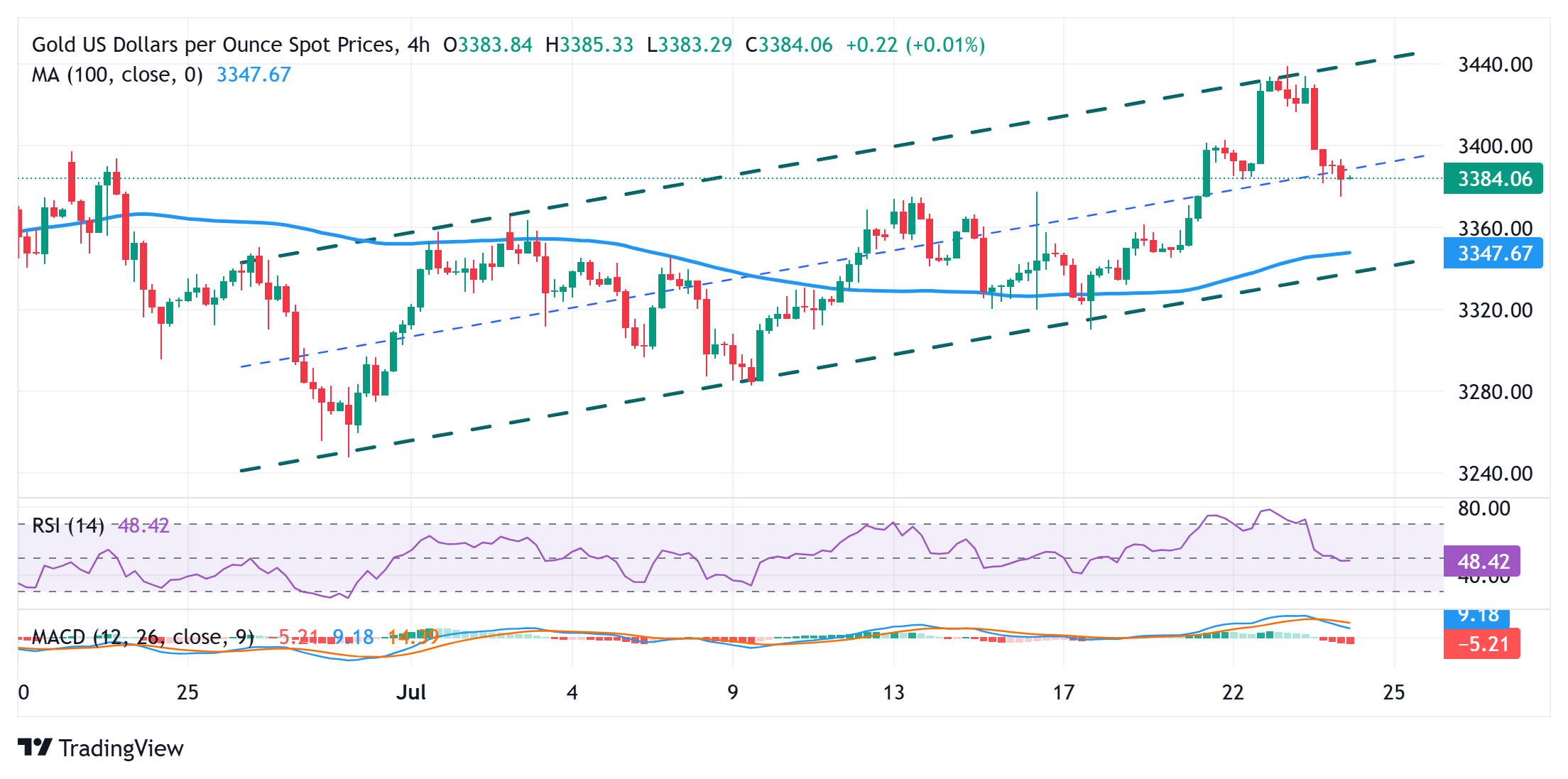Created
: 2025.07.24














![]() 2025.07.24 13:22
2025.07.24 13:22
Gold price (XAU/USD) remains on the defensive during the Asian session on Thursday and looks to extend the previous day's sharp retracement slide from its highest level since June 16. Reports that the US and the European Union (EU) are closing in on a tariff deal add to the optimism led by the US-Japan trade agreement. This remains supportive of the upbeat market mood and turns out to be a key factor undermining demand for the safe-haven bullion.
However, a combination of factors could act as a tailwind for the Gold price and limit deeper losses. Investors remain uncertain about the likely timing and the pace of interest rate cuts by the Federal Reserve (Fed). Adding to this, fears that the central bank's independence could be under threat from mounting political interference keep the US Dollar (USD) depressed near a two-week low and could offer support to the non-yielding yellow metal.

From a technical perspective, the recent move up along an upward sloping channel since the beginning of this month points to a well-established short-term uptrend. Adding to this, positive oscillators on the daily chart suggest that the Gold price is more likely to find decent support near the $3,370-3,368 strong horizontal resistance breakpoint. A convincing break below the said area, however, could expose the lower end of the trend-channel, currently pegged near the $3,333-3,332 region. The latter should act as a key pivotal point, which if broken decisively might shift the near-term bias in favor of the XAU/USD bears.
On the flip side, momentum back above the $3,400 mark could pause near the $3,438-3,440 static barrier. This coincides with the trend-channel resistance, above which the Gold price could accelerate the positive move towards challenging the all-time peak, around the $3,500 psychological mark touched in April.
Tariffs are customs duties levied on certain merchandise imports or a category of products. Tariffs are designed to help local producers and manufacturers be more competitive in the market by providing a price advantage over similar goods that can be imported. Tariffs are widely used as tools of protectionism, along with trade barriers and import quotas.
Although tariffs and taxes both generate government revenue to fund public goods and services, they have several distinctions. Tariffs are prepaid at the port of entry, while taxes are paid at the time of purchase. Taxes are imposed on individual taxpayers and businesses, while tariffs are paid by importers.
There are two schools of thought among economists regarding the usage of tariffs. While some argue that tariffs are necessary to protect domestic industries and address trade imbalances, others see them as a harmful tool that could potentially drive prices higher over the long term and lead to a damaging trade war by encouraging tit-for-tat tariffs.
During the run-up to the presidential election in November 2024, Donald Trump made it clear that he intends to use tariffs to support the US economy and American producers. In 2024, Mexico, China and Canada accounted for 42% of total US imports. In this period, Mexico stood out as the top exporter with $466.6 billion, according to the US Census Bureau. Hence, Trump wants to focus on these three nations when imposing tariffs. He also plans to use the revenue generated through tariffs to lower personal income taxes.
![]()
Created
: 2025.07.24
![]()
Last updated
: 2025.07.24

FXStreet is a forex information website, delivering market analysis and news articles 24/7.
It features a number of articles contributed by well-known analysts, in addition to the ones by its editorial team.
Founded in 2000 by Francesc Riverola, a Spanish economist, it has grown to become a world-renowned information website.
We hope you find this article useful. Any comments or suggestions will be greatly appreciated.
We are also looking for writers with extensive experience in forex and crypto to join us.
please contact us at [email protected].
Disclaimer:
All information and content provided on this website is provided for informational purposes only and is not intended to solicit any investment. Although all efforts are made in order to ensure that the information is correct, no guarantee is provided for the accuracy of any content on this website. Any decision made shall be the responsibility of the investor and Myforex does not take any responsibility whatsoever regarding the use of any information provided herein.
The content provided on this website belongs to Myforex and, where stated, the relevant licensors. All rights are reserved by Myforex and the relevant licensors, and no content of this website, whether in full or in part, shall be copied or displayed elsewhere without the explicit written permission of the relevant copyright holder. If you wish to use any part of the content provided on this website, please ensure that you contact Myforex.
Myforex uses cookies to improve the convenience and functionality of this website. This website may include cookies not only by us but also by third parties (advertisers, log analysts, etc.) for the purpose of tracking the activities of users. Cookie policy